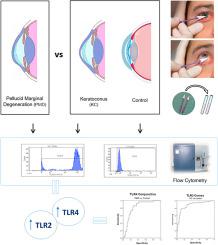Experimental Eye Research ( IF 3.0 ) Pub Date : 2020-09-02 , DOI: 10.1016/j.exer.2020.108211 Uxía Regueiro 1 , María Pérez-Mato 2 , Pablo Hervella 2 , Francisco Campos 2 , Tomás Sobrino 2 , Isabel Lema 3

|
The main purpose of this study is to evaluate the diagnostic role of Toll-like receptors 2 (TLR2) and 4 (TLR4) expression in corneal and conjunctival epithelial cells of eyes with pellucid marginal degeneration (PMD) compared to keratoconus patients (KC) and control subjects. A prospective case-control study in 29 PMD eyes, 109 KC eyes and 72 healthy eyes was done. All participants were subjected to a clinical, topographic, aberrometric and tomographic exam with extraction of corneal and conjunctival epithelial cells through scraping. The TLR2 and TLR4 expression was measured with flow cytometry. Receiver operating characteristic (ROC) curve analysis was used to determine the most appropriate cutoff point for predicting the risk of PMD and KC. Correlations between TLR2/TLR4 expression and the severity of PMD/KC were evaluated. A TLRs follow-up review was made 19 ± 4 months after to the first review. As result, mean expression of TLR2 and TLR4 in both corneal and conjunctival epithelial cells was significantly higher in eyes with corneal ectasia (PMD and KC) than in control eyes (all p < 0.05). Conjunctival TLR4 expression showed the highest capacity to diagnose the existence of PMD (odd ratio 42.84; 95% confidence interval:6.20–296.20; p < 0.0001) after adjusting by eye rubbing and steeper corneal meridian. Moreover, we found an association between the TLR2/TLR4 overexpression with the severity of the PMD and KC measured by corneal topographic, aberrometric and tomographic quantitative parameters (all p < 0.05). Differences on TLR2/TLR4 expression between study groups were maintained during the follow-up period. In conclusion, the TLR2/TLR4 overexpression in corneal and conjunctival epithelial cells of PMD and KC patients compared to healthy control subjects have demonstrated their role as diagnostic target in both corneal ectatic disorders.
中文翻译:

Toll样受体作为透明边缘变性的诊断目标。
这项研究的主要目的是评估与圆锥角膜病患者(KC)和圆锥角膜病患者相比,透明性边缘变性(PMD)的角膜和结膜上皮细胞中Toll样受体2(TLR2)和4(TLR4)表达的诊断作用控制对象。进行了一项前瞻性病例对照研究,研究对象为29只PMD眼,109只KC眼和72只健康眼。所有参与者均接受了临床,地形,像差和断层扫描检查,并通过刮擦提取了角膜和结膜上皮细胞。用流式细胞术测量TLR2和TLR4的表达。接收者操作特征(ROC)曲线分析用于确定最合适的临界点,以预测PMD和KC的风险。评价了TLR2 / TLR4表达与PMD / KC严重程度之间的相关性。在第一次审查后19±4个月进行了TLR随访审查。结果,在角膜扩张的眼(PMD和KC)中,角膜和结膜上皮细胞中TLR2和TLR4的平均表达明显高于对照眼(所有p <0.05)。结膜TLR4的表达显示出最高的诊断PMD的能力(奇数比42.84; 95%置信区间:6.20–296.20; p <0.0001),这是通过揉搓和陡峭的角膜子午线进行调整后得出的。此外,我们发现TLR2 / TLR4过表达与通过角膜地形图,像差法和断层扫描定量参数测量的PMD和KC严重程度之间存在关联(所有p <0.05)。在随访期间,研究组之间保持了TLR2 / TLR4表达的差异。结论,











































 京公网安备 11010802027423号
京公网安备 11010802027423号